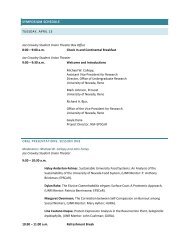Student Research Programs - Office of Undergraduate and ...
Student Research Programs - Office of Undergraduate and ...
Student Research Programs - Office of Undergraduate and ...
You also want an ePaper? Increase the reach of your titles
YUMPU automatically turns print PDFs into web optimized ePapers that Google loves.
long infection without causing any disease symptoms in healthy individuals. However, it causes various<br />
lymphoproliferative diseases in immune compromised individuals including the AIDS patients. In the infected<br />
cells, KSHV remains latent <strong>and</strong> expresses only a subset <strong>of</strong> genes. Latency Associated Nuclear Antigen (LANA) is<br />
among the proteins expressed during latency <strong>and</strong> is important for tethering the KSHV episomal DNA to the host<br />
chromosomes. LANA interacts with various cellular <strong>and</strong> viral proteins <strong>and</strong> is classified as an oncogene. LANA is<br />
known to bind to terminal repeats in the KSHV genome, facilitate viral DNA replication <strong>and</strong> is important for<br />
episomal maintenance, but lacks any enzymatic activity, suggesting the recruitment <strong>of</strong> host replication machinery.<br />
A previous LANA binding affinity column identified Topoisomerase II Beta (TopoIIb) as an LANA interacting<br />
protein. TopoIIb is required for cellular DNA replication therefore we hypothesized that LANA recruits TopoIIb at<br />
the site <strong>of</strong> replication to initiate DNA replication. Here, we characterized the binding <strong>of</strong> TopoIIb with LANA using<br />
immunoprecipitation assay. We also determined the binding <strong>of</strong> topoIIb with LANA in a co-localization assay in<br />
KSHV infected tumor cells. In our immunoprecipitation assay, TopoIIb bound to LANA full length <strong>and</strong> the binding<br />
region was mapped to the N-terminal domain <strong>of</strong> LANA. Using a confocal microscopy, we were able to find distinct<br />
nuclear compartments with LANA <strong>and</strong> TopoIIb co-localizing together in KSHV infected, BCBL-1 tumor cells. These<br />
results confirmed our hypothesis that LANA recruits TopoIIb for the replication <strong>of</strong> viral DNA.<br />
DETERMINING THE ROLE OF LANA IN CHROMATIN REMODELING<br />
Shanthan Challa<br />
Program: NIH INBRE<br />
Mentor: Subhash Verma<br />
Department: Biochemistry <strong>and</strong> Molecular Biology<br />
University <strong>of</strong> Nevada, Reno<br />
Kaposi’s Sarcoma associated Herpesvirus (KSHV) also called Human Herpesvirus 8<br />
(HHV8) is linked to primary effusion lymphomas (PELs) <strong>and</strong> multicentric castleman’s<br />
disease (MCDs). KSHV causes tumors predominantly in HIV+ immunocompromised<br />
patients <strong>and</strong> is among the leading cause <strong>of</strong> AIDS related deaths. Although the<br />
introduction <strong>of</strong> HAART for the treatment <strong>of</strong> HIV/AIDS has reduced the risk <strong>of</strong> KSHV<br />
induced tumors but the virus remains present in the infected individuals <strong>and</strong> causes<br />
these KS tumors to reoccur. Therefore, KSHV specific drugs are needed to eliminate<br />
virus from infected individuals. KSHV, like other herpesvirus persists indefinitely in the infected host <strong>and</strong> exhibit<br />
two distinct phases, latency <strong>and</strong> lytic. During latency, only a subsets <strong>of</strong> genes are expressed <strong>and</strong> the Latency<br />
Associated Nuclear Antigen (LANA) is among the most expressed proteins in all KSHV tumors. Our yeast-2-hybrid<br />
data with LANA as bait identified a component <strong>of</strong> the chromatin remodeling <strong>and</strong> deacetylase (NuRD) complex,<br />
CHD4 (Chromodomain Helicase DNA binding protein 4) suggesting its role in viral chromatin modulation. Since<br />
chromatin remodeling plays an important role in viral reactivation <strong>and</strong> tumorigenesis a better underst<strong>and</strong>ing <strong>of</strong><br />
the regulation <strong>of</strong> chromatin structure is warranted in controlling viral infections <strong>and</strong> viral-associated<br />
tumorigenesis. We hypothesize that LANA might be recruiting CHD4 at the viral chromatin to modulate the<br />
expression <strong>of</strong> viral genes for establishment <strong>of</strong> latency. Immuno Florescence Assay on BCBL <strong>and</strong> Hela cells showed<br />
that LANA <strong>and</strong> CHD4 co-localize in-vivo. Co-immunoprecipitation analysis was performed with over expressed<br />
LANA <strong>and</strong> CHD4 in HEK293 cells <strong>and</strong> we found out that LANA does interact with CHD4 for expression <strong>of</strong> viral<br />
genes. To map the specific binding region <strong>of</strong> CHD4 with LANA , co-immunoprecipitation analysis was done with<br />
cells expressing CHD4 Wild type, N-terminus <strong>and</strong> C-terminus along with LANA. The result indicated that LANA colocalizes<br />
with CHD4 <strong>and</strong> binds to its N-terminus.<br />
8











